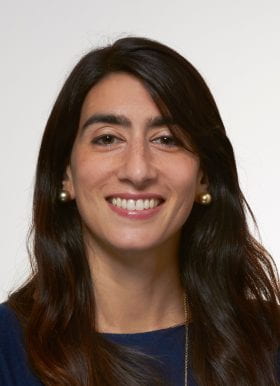
Ream Al-Hasani, PhD, holds a primary appointment as assistant professor in the Department of Pharmaceutical and Administrative Sciences at the University of Health Sciences & Pharmacy and an adjunct appointment as assistant professor in the Department of Anesthesiology at WUSM. Al-Hasani’s interest in neuroscience began during her undergraduate years studying pharmacology at the University of Portsmouth in the United Kingdom. While at the University of Portsmouth, she secured an internship at GlaxoSmithKline studying neurodegenerative diseases.
Following these formative experiences, Al-Hasani focused her interests on addiction, by pursuing a Medical Research Council-funded Doctor of Philosophy in neuropharmacology at the University of Surrey where she studied the involvement of adenosine A2 receptors in morphine and cocaine addiction.
Al-Hasani completed her postdoctoral training in the Department of Anesthesiology at WUSM. There, she focused on dissecting the role of the opioid circuitry in motivated behaviors. Her work has clarified the role of chronic, mild stress on noradrenergic systems and has uncovered new roles for cue-induced reinstatement of morphine seeking behavior.
In 2015, Al-Hasani was awarded the prestigious Pathway to Independence Award (K99/R00) from the National Institute on Drug Abuse for her work implementing wireless optogenetics, in vivo neuropeptide detection and neural circuit tracing, that led to the identification of two distinct subpopulations of behaviors. The award provided her with an additional two years of mentored phase funding and three years of R01-like funding to use in her own independent laboratory.
In her laboratory at the center, Al-Hasani will continue to use multidisciplinary approaches to further our understanding of the negative affective behaviors associated with the withdrawal phase of addiction and the interaction of endogenous opioid systems with commonly prescribed opioid analgesics.
“It’s a new venture and a chance to do what everyone’s been trying to do—bridge basic research with clinical research,” Al-Hasani said. “To have both the clinical and basic aspects in one building adds a lot of strength. It’s invigorating to be a part of the growth of the center and help shape it into what it will become.”